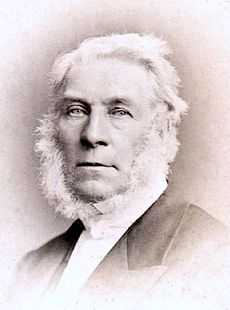James Glaisher
| James Glaisher | |
|---|---|
|
James Glaisher | |
| Born | 7 April 1809 |
| Died | 7 February 1903 |
| Nationality | English |
| Fields | meteorology |
James Glaisher FRS (7 April 1809 – 7 February 1903) was an English meteorologist and aeronaut.
Born in Rotherhithe, the son of a London watchmaker,[1] Glaisher was a Junior assistant at the Cambridge Observatory from 1833 to 1835[2] before moving to the Royal Greenwich Observatories, where he served as Superintendent of the Department of Meteorology and Magnetism at Greenwich for thirty-four years.
In 1845, Glaisher published his dew point tables, for the measurement of humidity. He was elected a Fellow of the Royal Society in June 1849.[3]
He was a founder member of the Meteorological Society (1850) and the Aeronautical Society of Great Britain (1866). He was president of the Royal Meteorological Society from 1867 to 1868. Glaisher was elected a member of The Photographic Society, later the Royal Photographic Society, in 1854 and served as the Society's President between 1869-1874 and 1975-1892.[4] He remained a member until his death.
He is most famous, however, as a pioneering balloonist. Between 1862 and 1866, usually with Henry Tracey Coxwell as his co-pilot, Glaisher made numerous ascents in order to measure the temperature and humidity of the atmosphere at its highest levels. His ascent on 5 September 1862 broke the world record for altitude, but he passed out around 8,800 metres before a reading could be taken. One of the pigeons making the trip with him died.[5] Estimates suggest that he rose to more than 9,500 metres and as much as 10,900 metres above sea-level.[6][7][8]
Glaisher lived at 22 Dartmouth Hill, Blackheath, London, where there is a blue plaque in his memory. He died in Croydon, Surrey in 1903.
He had married in 1843 Cecilia Louisa, a daughter of Henry Belville, Assistant at the Royal Observatory, Greenwich. James and Cecilia Glaisher had three children, including the mathematician James Whitbread Lee Glaisher (1848–1928).
A lunar crater is named after him.
Notes
- ↑ H. P. Hollis, ‘Glaisher, James (1809–1903)’, rev. J. Tucker, Oxford Dictionary of National Biography, Oxford University Press, 2004; online edn, Oct 2008, accessed 5 Jan 2009
- ↑ Stratton, F.J.M. "The History of the Cambridge Observatories", Annals of the Solar Physics Observatory, Cambridge Vol. I (1949)
- ↑ "Library and Archive Catalogue". Royal Society. Retrieved 29 December 2010.
- ↑ Presidents 1853-2013. www.rps.org and http://rpsmembers.dmu.ac.uk/rps_results.php?mid=130. Accessed 6 March 2015.
- ↑ Appletons' annual cyclopaedia and register of important events of the year: 1862. New York: D. Appleton & Company. 1863. p. 186.
- ↑ Centennial of Flight
- ↑ 1902 Encyclopedia
- ↑ http://www.localhistory.scit.wlv.ac.uk/articles/BalloonFlight/Flight.htm
Jennifer Tucker. "Voyages of Discovery on Oceans of Air: Scientific Observation and the Image of Science in an Age of "Balloonacy"" Osiris, 2nd series, Volume 11, "Science in the Field" (1996):144-176.
References
- Glaisher, James. Travels in the Air. London: Bentley, 1871; Philadelphia: J.B. Lippincott, 1871. Extract
External links
-
 "Glaisher, James". Encyclopædia Britannica (11th ed.). 1911.
"Glaisher, James". Encyclopædia Britannica (11th ed.). 1911. - Royal Society citation
- Newspaper cutting from New York Times, 1909.
- Details of 1862 balloon flight.
- NOAA photo library – Illus. from Glaisher's 1871 'Travels in the Air'; see #634–641
|
